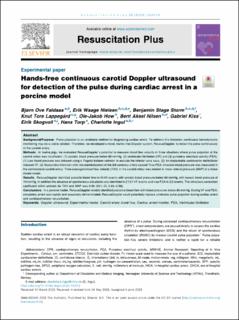| dc.contributor.author | Faldaas, Bjørn Ove | |
| dc.contributor.author | Nielsen, Erik Waage | |
| dc.contributor.author | Storm, Benjamin | |
| dc.contributor.author | Lappegård, Knut Tore | |
| dc.contributor.author | How, Ole-Jakob | |
| dc.contributor.author | Nilsen, Bent Aksel | |
| dc.contributor.author | Kiss, Gabriel Hanssen | |
| dc.contributor.author | Skogvoll, Eirik | |
| dc.contributor.author | Torp, Hans | |
| dc.contributor.author | Ingul, Charlotte Ingeborg Björk | |
| dc.date.accessioned | 2023-07-24T09:11:04Z | |
| dc.date.available | 2023-07-24T09:11:04Z | |
| dc.date.created | 2023-06-29T10:43:21Z | |
| dc.date.issued | 2023 | |
| dc.identifier.citation | Resuscitation Plus. 2023, 15 . | |
| dc.identifier.issn | 2666-5204 | |
| dc.identifier.uri | https://hdl.handle.net/11250/3081058 | |
| dc.description.abstract | Background/Purpose
Pulse palpation is an unreliable method for diagnosing cardiac arrest. To address this limitation, continuous hemodynamic monitoring may be a viable solution. Therefore, we developed a novel, hands-free Doppler system, RescueDoppler, to detect the pulse continuously in the carotid artery.
Methods
In twelve pigs, we evaluated RescueDoppleŕs potential to measure blood flow velocity in three situations where pulse palpation of the carotid artery was insufficient: (1) systolic blood pressure below 60 mmHg, (2) ventricular fibrillation (VF) and (3) pulseless electrical activity (PEA). (1) Low blood pressure was induced using a Fogarty balloon catheter to occlude the inferior vena cava. (2) An implantable cardioverter-defibrillator induced VF. (3) Myocardial infarction after microembolization of the left coronary artery caused True-PEA. Invasive blood pressure was measured in the contralateral carotid artery. Time-averaged blood flow velocity (TAV) in the carotid artery was related to mean arterial pressure (MAP) in a linear mixed model.
Results
RescueDoppler identified pulsatile blood flow in 41/41 events with systolic blood pressure below 60 mmHg, with lowest blood pressure of 19 mmHg. In addition the absence of spontaneous circulation was identified in 21/21 VF events and true PEA in 2/2 events. The intraclass correlation coefficient within animals for TAV and MAP was 0.94 (95% CI. 0.85–0.98).
Conclusions
In a porcine model, RescueDoppler reliably identified pulsative blood flow with blood pressures below 60 mmHg. During VF and PEA, circulatory arrest was rapidly and accurately demonstrated. RescueDoppler could potentially replace unreliable pulse palpation during cardiac arrest and cardiopulmonary resuscitation. | |
| dc.language.iso | eng | |
| dc.publisher | Elsevier | |
| dc.rights.uri | http://creativecommons.org/licenses/by/4.0/deed.no | |
| dc.title | Hands-free continuous carotid Doppler ultrasound for detection of the pulse during cardiac arrest in a porcine model | |
| dc.title.alternative | Hands-free continuous carotid Doppler ultrasound for detection of the pulse during cardiac arrest in a porcine model | |
| dc.type | Peer reviewed | |
| dc.type | Journal article | |
| dc.description.version | publishedVersion | |
| dc.source.pagenumber | 0 | |
| dc.source.volume | 15 | |
| dc.source.journal | Resuscitation Plus | |
| dc.identifier.doi | 10.1016/j.resplu.2023.100412 | |
| dc.identifier.cristin | 2159354 | |
| cristin.ispublished | true | |
| cristin.fulltext | original | |
| cristin.qualitycode | 1 | |

